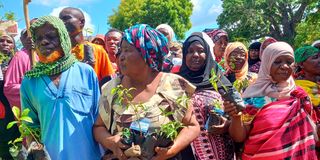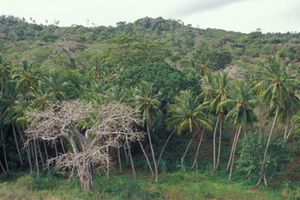Kaya elders embark on restoration of degraded sacred forests

Residents from Tiwi in Kwale County carry seedlings to be replanted at Kaya Tiwi Forest. They have raised concerns over land grabbing that has led to degradation of Kaya forest.
What you need to know:
- The forests, dominated by indigenous trees, are not only sacred for the Mijikenda Community, but are also valuable habitats many rare plant and animal species.
- But the once lush green forests are now threatened by climate change, development, land grabbing and other human activities.
For a long time, Kaya forests have played a critical role in the culture of the Coastal people. The forests, more like shrines, are highly protected areas and are regarded as sacred sites.
The forests, dominated by indigenous trees, are not only sacred for the Mijikenda Community, but are also valuable habitats many rare plant and animal species.

A section of a degraded Kaya forest in Matuga.
But the once lush green forests are now threatened by climate change, development, land grabbing and other human activities, a move that has led to the disappearance of many indigenous trees. Prolonged drought has equally led to land degradation in the forests.
The felling of trees has since raised great concern among Kaya elders, who not only fear losing their culture but also say that deforestation is causing calamities such as drought and floods.
Kaya elders are revered members in the Mijikenda community who provide blessings and interpretation services to locals. They are tasked with protecting the shrines (Kayas) and they occasionally meet in Kaya forests, which are sacred places where prayers and cultural rituals are done.
A spot check by Healthy Nation found that most of the Kaya forests in Kwale County have suffered massive destruction and are disappearing, with many trees cut down and other forest areas fenced off in preparation for development.
This degradation of indigenous trees coupled with harsh climate change effects has led to the launch of a restoration project by Kaya elders to plant at least 10,000 trees in the forests.
At the Kaya Tiwi Forest, the Healthy Nation team finds at least 50 elderly community members planting trees. Despite the scorching sun, they struggle to restore what was once their haven and sacred place.
“We would meet here a few years ago to plan some cultural ceremonies and hold prayers. The environment was good and calm; filled with trees and birds. But that is no longer the case.
“We want to make sure that our old forests are back to life. This forest has been in existence for more than 700 years and we have a responsibility to conserve it for the future generation,” said Ali Mwachangu, a Kaya elder.
Mr Mwachangu is among the elders who have taken the initiative to restore the dignity of the sacred forests and help combat climate change through conservation efforts.
Ms Nlela Saidi, one of the female elders, is also among those who are restoring the forest.
Like the rest, she rose to the coveted position of being a custodian of the shrine through her good reputation in the community.
But the fear of losing her cultural heritage has engulfed her.
"Many communities have their traditional knowledge and culture. But we are worried about losing ours because our trees are being cut by grabbers. We are finding it hard to protect this forest that plays a significant role in the community," she said.
She believes that the tree-planting campaign will not only restore their culture but also revive the beauty of Kaya Tiwi, which lies next to Indian Ocean. She also believes that trees play an important role in attracting rain, which will be vital in reducing the risk of drought.
"These trees are important because through them, we will get more rainfall like was the case before. We have been having prolonged droughts because the trees were cut down.”
Mr Hamisi Bwika, another elder, reminisced the days when he used to see his grandfather visit the shrine for prayers. He said restoring Kaya Tiwi means bringing it back to life and reviving its ancestral history through conservation.
"We have seen impacts of climate change that are coming as a result of deforestation. Our area used to receive so much rainfall, but that is not the case nowadays," he said.
He urged the government to support the restoration initiative and help reclaim areas that have been grabbed.
Kwale County has 38 gazetted Kaya forests, according to National Museums of Kenya Kwale Coordinator Matano Abdulrahman, two of which have been recognised by UNESCO as World Heritage Sites.
So far, the elders have planted 5,000 trees at Kaya Tiwi.
They plan to plan 5,000 more in the coming days. "Many of us are old and we are facing challenges with the scorching sun. We wish that we could have planted all the 10,000 trees at once," Mr Hamisi Mwajao, an elder, said.
He noted that they acquired tree seedlings from the Kenya Forest Service headquarters in Kwale County.
Mr Mwajao said the elders have recently formed new partnerships with other conservation organisations that will promote their mission to restore the degraded forests.
Other than cultural practices, the elders also plan to put some of the forests into use by practising ecotourism.
For instance, they will be taking visitors around the Kayas while showing them their culture. The Mijikenda community uses the Kaya shrines to appease their gods and ask for divine powers for prosperity and for curing diseases.
The elders added that President William Ruto should end historical land injustices, noting that the move will help reduce degradation of natural forests.





